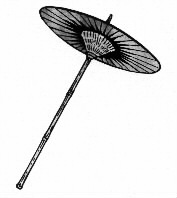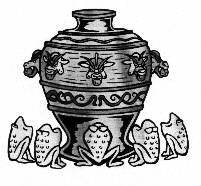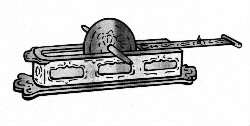ANCIENT CHINESE
CONTRIBUTIONS
Chinese Inventions
Umbrella

Umbrellas were invented by the Chinese.
The umbrellas were made from oiled paper because oil repels water. The
frames of the umbrellas were made from mulberry bark or bamboo. Red and
yellow umbrellas were used by royalty, and
blue umbrellas were used by the common people. The Chinese also used
umbrellas to keep the sun off their skin.
Seismograph
During the Han Dynasty an astronomer
invented this earthquake device to give warning of an
 earthquake. The
seismograph looks like a bronze vase covered with dragons and toads.
Inside the vase swung a long metal pendulum. Outside the vase, eight
dragons' heads were mounted onto its sides. The dragon heads were evenly
spaced apart and each dragon had a ball in its mouth. Below each dragon
was a toad, with its mouth open.
earthquake. The
seismograph looks like a bronze vase covered with dragons and toads.
Inside the vase swung a long metal pendulum. Outside the vase, eight
dragons' heads were mounted onto its sides. The dragon heads were evenly
spaced apart and each dragon had a ball in its mouth. Below each dragon
was a toad, with its mouth open.
When an earthquake occurred, the pendulum
would swing in the direction in which the earthquakeoccurred.
The pendulum would hit a rod inside the vase. This rod would knock a
ball out of a dragon's mouth. The ball would drop into the toad's mouth.
The ball came out in the direction in which the earthquake had occurred.
This would signal an earthquake.
The ancient Chinese needed this
invention because
China
experienced many devastating earthquakes.
The Chinese could provide more help to the earthquake victims if they
were able to tell the direction that they should head with the supplies.
Remember that during the time period of ancient
China
there were no methods of fast
communication available; therefore, it was important to have a clue
where to head with the supplies.
Blast Furnace
In the 6th century B.C.
, the ancient Chinese were the first people to use cast iron for
tools, weapons, and cooking pots. It was a long process to make the cast
iron. Therefore, in the first century A.D. ,
a blast furnace was invented by an unknown person. The blast furnace was
powered by steam and boiling water. The furnace shot out hot air which
heated the iron. Heated iron is much easier to work with. This early
furnace might have opened the way for the creation of steel.

Tea Shredder

The ancient Chinese loved to drink tea.
Drinking tea became very popular during the Tang Dynasty. At first, tea
leaves had to be chopped or shredded by hand which was very
time-consuming. A Chinese inventor created the tea shredder. The tea
shredder had a wheel in the center which would slice the tea leaves into
thin strips. This would make the job easier and less time-consuming.

Wheelbarrow
 The wheelbarrow was invented by the
Chinese. The Chinese wheelbarrow had a single wheel in the middle of the
wheelbarrow. Farmers used the wheelbarrow to take a load of produce to
the market place. Builders used the wheelbarrow to carry heavy building
supplies. Soldiers used the wheelbarrow to remove injured or dead people
from the battlefield.
The wheelbarrow was invented by the
Chinese. The Chinese wheelbarrow had a single wheel in the middle of the
wheelbarrow. Farmers used the wheelbarrow to take a load of produce to
the market place. Builders used the wheelbarrow to carry heavy building
supplies. Soldiers used the wheelbarrow to remove injured or dead people
from the battlefield.
Yoke
The ancient Chinese laborer used a
yoke to carry things. A yoke is a stick that is carried across the
shoulders and back. Buckets are hung or objects are tied to the end of
the yoke. Many workers in isolated, rural areas of
China
today continue to use a yoke to carry
items.


Credits: Information and the black and
white pictures on this page came from Behind the Great Wall: A
Journey to the Middle Kingdom by Demco
Inc.
Paper
One of
China
's greatest contributions to the world was
the invention of paper. During the Han Dynasty
(around 200 B.C.), the Chinese used plant materials and silk rags to
make paper. They made durable, long-lasting paper by 105 A.D.
This paper became the common form of writing materials for records and
books. The Chinese also used paper for creating landscape and figure
paintings, windows, lanterns, umbrellas, and fans.
Other
Inventions / Contributions
Great
Wall
|
Fireworks
|
Gunpowder
|
Compass
|
Martial
Arts
|
Acupuncture
|
Movable
Type
|
|
Kites
|
Porcelain
|
Stirrups-Horseback
Riding
|
Junk
(Boat)
|
|
|
|
Silk Road
|
|
|
|
|
|
|
|
|
Silk
Road Map |
The
For thousands of years, items were
exchanged by Asian, European, and African civilizations. Because of
this, many trade routes were formed. However, beginning around 100 B.C.
there was a demand for
Ideas and goods were carried along
the
Travel along the
The
|
silk |
nuts |
food |
furs |
dyes |
|
flowers |
jade |
salt |
horses |
onions |
|
incense |
pepper |
tea |
spices |
oils |
Finally, the
From: http://www.wjcc.k12.va.us/djm/Ancient_Civilizations/china/contributions.htm
 Compass
Compass Boat
Boat


